Comprehensive Report on Food and Beverage Operations Management
VerifiedAdded on 2020/10/05
|16
|4898
|357
Report
AI Summary
This report provides a comprehensive analysis of food and beverage operations, encompassing various aspects of the industry. It begins by categorizing different types of businesses within the food and beverage sector, such as hotels, fast food, golf clubs, hospital catering, restaurants, contract catering, and cultural/heritage establishments, detailing their advantages, disadvantages, and notable examples. The report then explores national and international rating systems like Michelin stars, AA rosettes, and hotel star ratings, which are used to assess the quality and standards within the industry. Furthermore, it delves into current and future trends impacting food and beverage businesses, including the rising popularity of street food and the increasing emphasis on healthy and sustainable options. The report also examines professional food and beverage management skills, legal requirements, and the use of technology in operations and marketing. Finally, it investigates consumer decision-making factors and strategies for attracting and building a loyal customer base within the food and beverage sector.
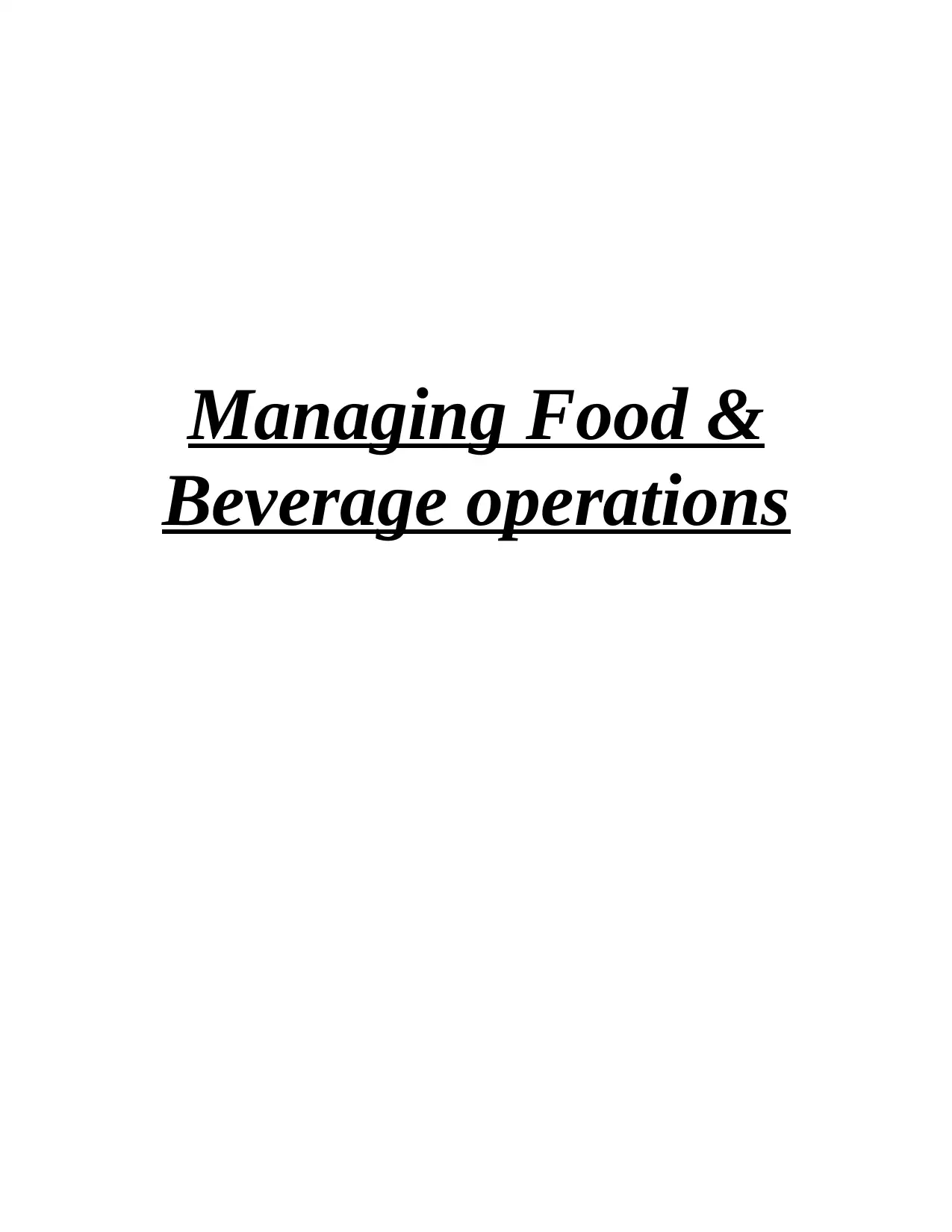
Managing Food &
Beverage operations
Beverage operations
Paraphrase This Document
Need a fresh take? Get an instant paraphrase of this document with our AI Paraphraser
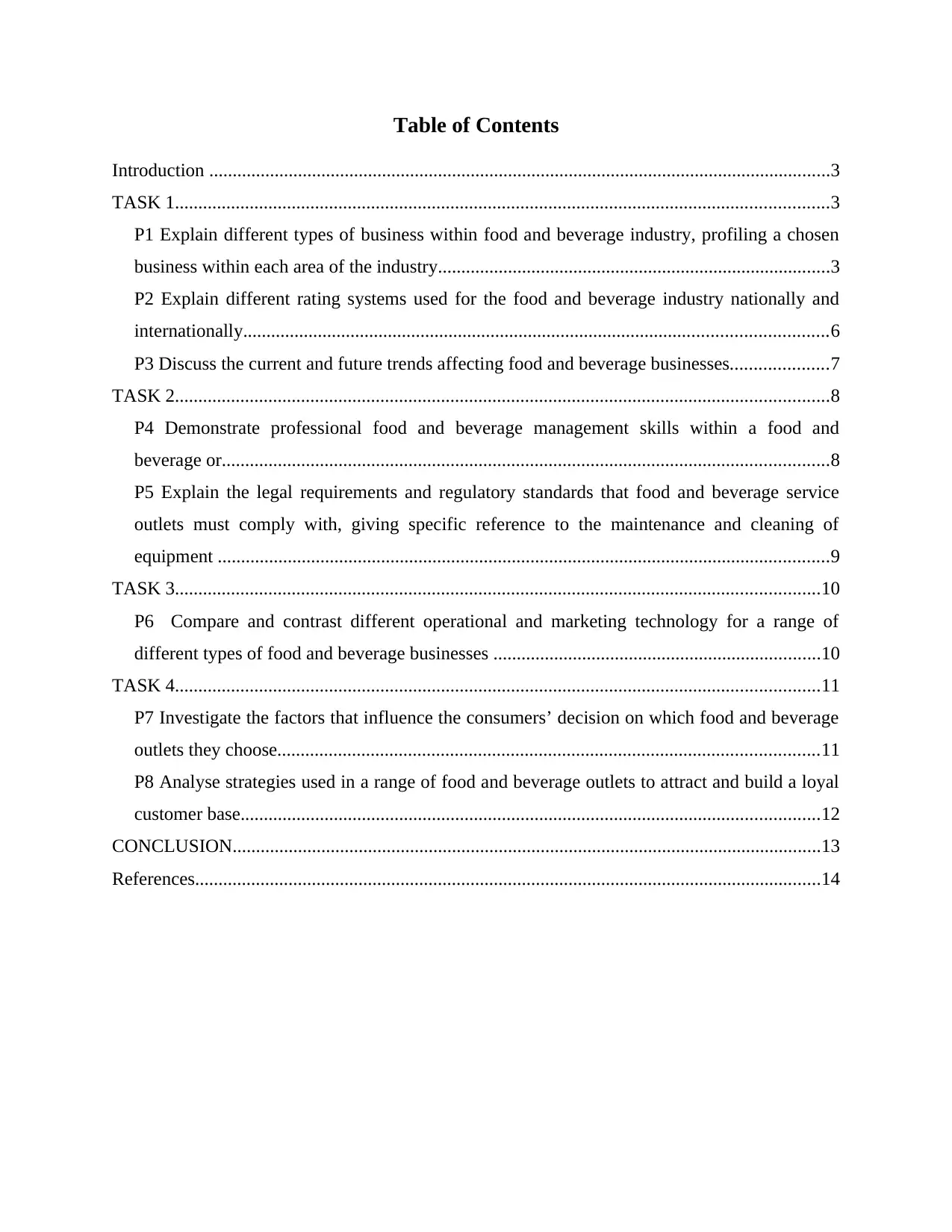
Table of Contents
Introduction .....................................................................................................................................3
TASK 1............................................................................................................................................3
P1 Explain different types of business within food and beverage industry, profiling a chosen
business within each area of the industry....................................................................................3
P2 Explain different rating systems used for the food and beverage industry nationally and
internationally.............................................................................................................................6
P3 Discuss the current and future trends affecting food and beverage businesses.....................7
TASK 2............................................................................................................................................8
P4 Demonstrate professional food and beverage management skills within a food and
beverage or..................................................................................................................................8
P5 Explain the legal requirements and regulatory standards that food and beverage service
outlets must comply with, giving specific reference to the maintenance and cleaning of
equipment ...................................................................................................................................9
TASK 3..........................................................................................................................................10
P6 Compare and contrast different operational and marketing technology for a range of
different types of food and beverage businesses ......................................................................10
TASK 4..........................................................................................................................................11
P7 Investigate the factors that influence the consumers’ decision on which food and beverage
outlets they choose....................................................................................................................11
P8 Analyse strategies used in a range of food and beverage outlets to attract and build a loyal
customer base............................................................................................................................12
CONCLUSION..............................................................................................................................13
References......................................................................................................................................14
Introduction .....................................................................................................................................3
TASK 1............................................................................................................................................3
P1 Explain different types of business within food and beverage industry, profiling a chosen
business within each area of the industry....................................................................................3
P2 Explain different rating systems used for the food and beverage industry nationally and
internationally.............................................................................................................................6
P3 Discuss the current and future trends affecting food and beverage businesses.....................7
TASK 2............................................................................................................................................8
P4 Demonstrate professional food and beverage management skills within a food and
beverage or..................................................................................................................................8
P5 Explain the legal requirements and regulatory standards that food and beverage service
outlets must comply with, giving specific reference to the maintenance and cleaning of
equipment ...................................................................................................................................9
TASK 3..........................................................................................................................................10
P6 Compare and contrast different operational and marketing technology for a range of
different types of food and beverage businesses ......................................................................10
TASK 4..........................................................................................................................................11
P7 Investigate the factors that influence the consumers’ decision on which food and beverage
outlets they choose....................................................................................................................11
P8 Analyse strategies used in a range of food and beverage outlets to attract and build a loyal
customer base............................................................................................................................12
CONCLUSION..............................................................................................................................13
References......................................................................................................................................14

⊘ This is a preview!⊘
Do you want full access?
Subscribe today to unlock all pages.

Trusted by 1+ million students worldwide
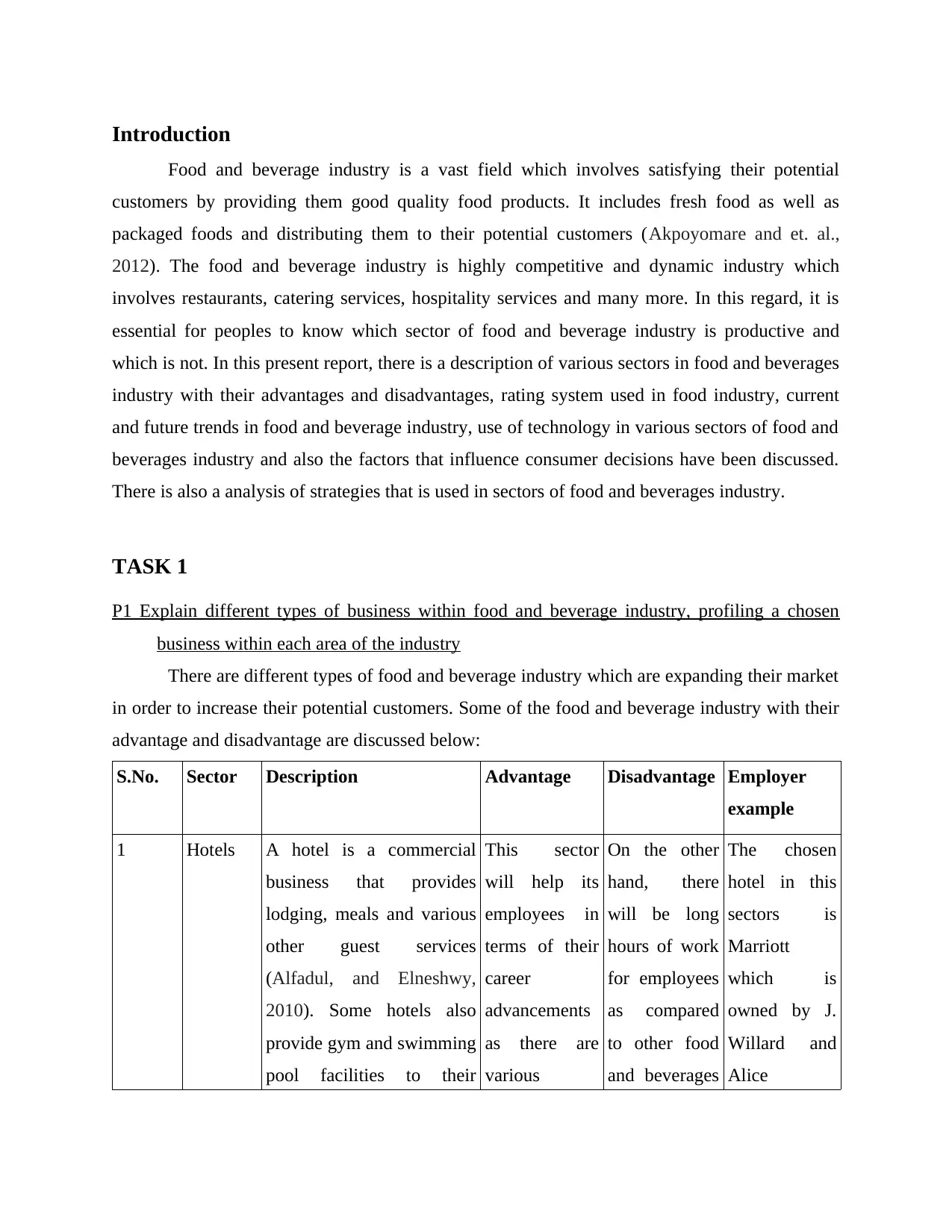
Introduction
Food and beverage industry is a vast field which involves satisfying their potential
customers by providing them good quality food products. It includes fresh food as well as
packaged foods and distributing them to their potential customers (Akpoyomare and et. al.,
2012). The food and beverage industry is highly competitive and dynamic industry which
involves restaurants, catering services, hospitality services and many more. In this regard, it is
essential for peoples to know which sector of food and beverage industry is productive and
which is not. In this present report, there is a description of various sectors in food and beverages
industry with their advantages and disadvantages, rating system used in food industry, current
and future trends in food and beverage industry, use of technology in various sectors of food and
beverages industry and also the factors that influence consumer decisions have been discussed.
There is also a analysis of strategies that is used in sectors of food and beverages industry.
TASK 1
P1 Explain different types of business within food and beverage industry, profiling a chosen
business within each area of the industry
There are different types of food and beverage industry which are expanding their market
in order to increase their potential customers. Some of the food and beverage industry with their
advantage and disadvantage are discussed below:
S.No. Sector Description Advantage Disadvantage Employer
example
1 Hotels A hotel is a commercial
business that provides
lodging, meals and various
other guest services
(Alfadul, and Elneshwy,
2010). Some hotels also
provide gym and swimming
pool facilities to their
This sector
will help its
employees in
terms of their
career
advancements
as there are
various
On the other
hand, there
will be long
hours of work
for employees
as compared
to other food
and beverages
The chosen
hotel in this
sectors is
Marriott
which is
owned by J.
Willard and
Alice
Food and beverage industry is a vast field which involves satisfying their potential
customers by providing them good quality food products. It includes fresh food as well as
packaged foods and distributing them to their potential customers (Akpoyomare and et. al.,
2012). The food and beverage industry is highly competitive and dynamic industry which
involves restaurants, catering services, hospitality services and many more. In this regard, it is
essential for peoples to know which sector of food and beverage industry is productive and
which is not. In this present report, there is a description of various sectors in food and beverages
industry with their advantages and disadvantages, rating system used in food industry, current
and future trends in food and beverage industry, use of technology in various sectors of food and
beverages industry and also the factors that influence consumer decisions have been discussed.
There is also a analysis of strategies that is used in sectors of food and beverages industry.
TASK 1
P1 Explain different types of business within food and beverage industry, profiling a chosen
business within each area of the industry
There are different types of food and beverage industry which are expanding their market
in order to increase their potential customers. Some of the food and beverage industry with their
advantage and disadvantage are discussed below:
S.No. Sector Description Advantage Disadvantage Employer
example
1 Hotels A hotel is a commercial
business that provides
lodging, meals and various
other guest services
(Alfadul, and Elneshwy,
2010). Some hotels also
provide gym and swimming
pool facilities to their
This sector
will help its
employees in
terms of their
career
advancements
as there are
various
On the other
hand, there
will be long
hours of work
for employees
as compared
to other food
and beverages
The chosen
hotel in this
sectors is
Marriott
which is
owned by J.
Willard and
Alice
Paraphrase This Document
Need a fresh take? Get an instant paraphrase of this document with our AI Paraphraser
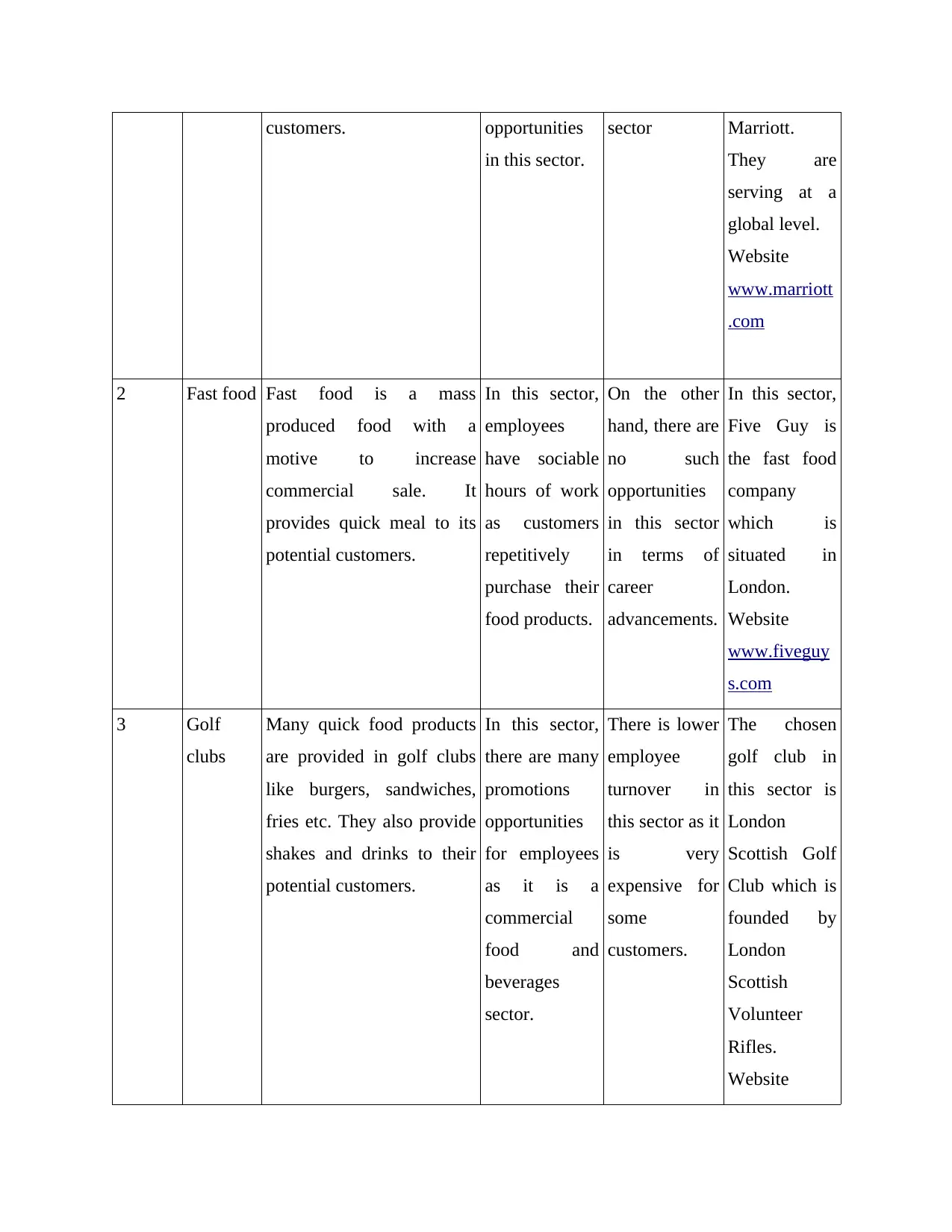
customers. opportunities
in this sector.
sector Marriott.
They are
serving at a
global level.
Website
www.marriott
.com
2 Fast food Fast food is a mass
produced food with a
motive to increase
commercial sale. It
provides quick meal to its
potential customers.
In this sector,
employees
have sociable
hours of work
as customers
repetitively
purchase their
food products.
On the other
hand, there are
no such
opportunities
in this sector
in terms of
career
advancements.
In this sector,
Five Guy is
the fast food
company
which is
situated in
London.
Website
www.fiveguy
s.com
3 Golf
clubs
Many quick food products
are provided in golf clubs
like burgers, sandwiches,
fries etc. They also provide
shakes and drinks to their
potential customers.
In this sector,
there are many
promotions
opportunities
for employees
as it is a
commercial
food and
beverages
sector.
There is lower
employee
turnover in
this sector as it
is very
expensive for
some
customers.
The chosen
golf club in
this sector is
London
Scottish Golf
Club which is
founded by
London
Scottish
Volunteer
Rifles.
Website
in this sector.
sector Marriott.
They are
serving at a
global level.
Website
www.marriott
.com
2 Fast food Fast food is a mass
produced food with a
motive to increase
commercial sale. It
provides quick meal to its
potential customers.
In this sector,
employees
have sociable
hours of work
as customers
repetitively
purchase their
food products.
On the other
hand, there are
no such
opportunities
in this sector
in terms of
career
advancements.
In this sector,
Five Guy is
the fast food
company
which is
situated in
London.
Website
www.fiveguy
s.com
3 Golf
clubs
Many quick food products
are provided in golf clubs
like burgers, sandwiches,
fries etc. They also provide
shakes and drinks to their
potential customers.
In this sector,
there are many
promotions
opportunities
for employees
as it is a
commercial
food and
beverages
sector.
There is lower
employee
turnover in
this sector as it
is very
expensive for
some
customers.
The chosen
golf club in
this sector is
London
Scottish Golf
Club which is
founded by
London
Scottish
Volunteer
Rifles.
Website
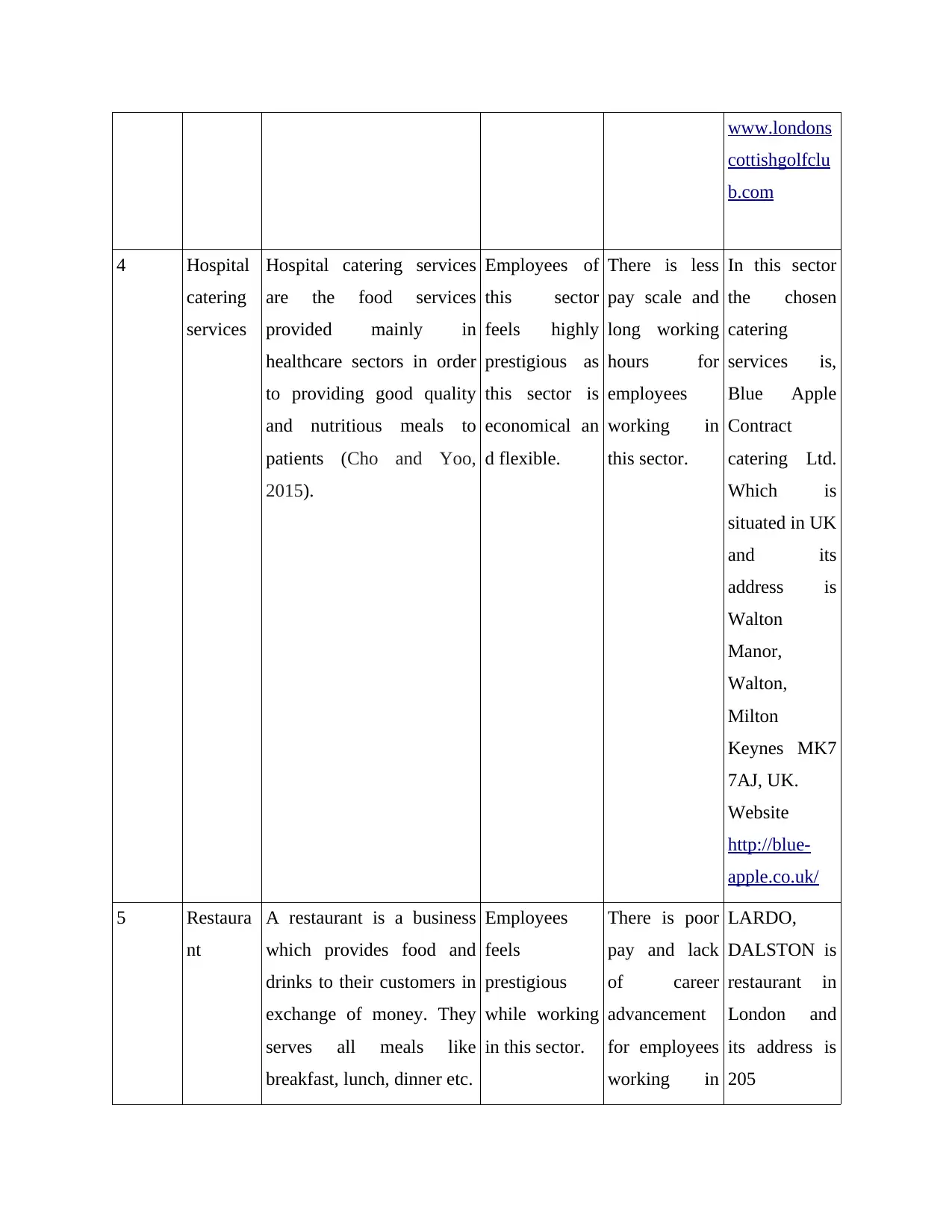
www.londons
cottishgolfclu
b.com
4 Hospital
catering
services
Hospital catering services
are the food services
provided mainly in
healthcare sectors in order
to providing good quality
and nutritious meals to
patients (Cho and Yoo,
2015).
Employees of
this sector
feels highly
prestigious as
this sector is
economical an
d flexible.
There is less
pay scale and
long working
hours for
employees
working in
this sector.
In this sector
the chosen
catering
services is,
Blue Apple
Contract
catering Ltd.
Which is
situated in UK
and its
address is
Walton
Manor,
Walton,
Milton
Keynes MK7
7AJ, UK.
Website
http://blue-
apple.co.uk/
5 Restaura
nt
A restaurant is a business
which provides food and
drinks to their customers in
exchange of money. They
serves all meals like
breakfast, lunch, dinner etc.
Employees
feels
prestigious
while working
in this sector.
There is poor
pay and lack
of career
advancement
for employees
working in
LARDO,
DALSTON is
restaurant in
London and
its address is
205
cottishgolfclu
b.com
4 Hospital
catering
services
Hospital catering services
are the food services
provided mainly in
healthcare sectors in order
to providing good quality
and nutritious meals to
patients (Cho and Yoo,
2015).
Employees of
this sector
feels highly
prestigious as
this sector is
economical an
d flexible.
There is less
pay scale and
long working
hours for
employees
working in
this sector.
In this sector
the chosen
catering
services is,
Blue Apple
Contract
catering Ltd.
Which is
situated in UK
and its
address is
Walton
Manor,
Walton,
Milton
Keynes MK7
7AJ, UK.
Website
http://blue-
apple.co.uk/
5 Restaura
nt
A restaurant is a business
which provides food and
drinks to their customers in
exchange of money. They
serves all meals like
breakfast, lunch, dinner etc.
Employees
feels
prestigious
while working
in this sector.
There is poor
pay and lack
of career
advancement
for employees
working in
LARDO,
DALSTON is
restaurant in
London and
its address is
205
⊘ This is a preview!⊘
Do you want full access?
Subscribe today to unlock all pages.

Trusted by 1+ million students worldwide
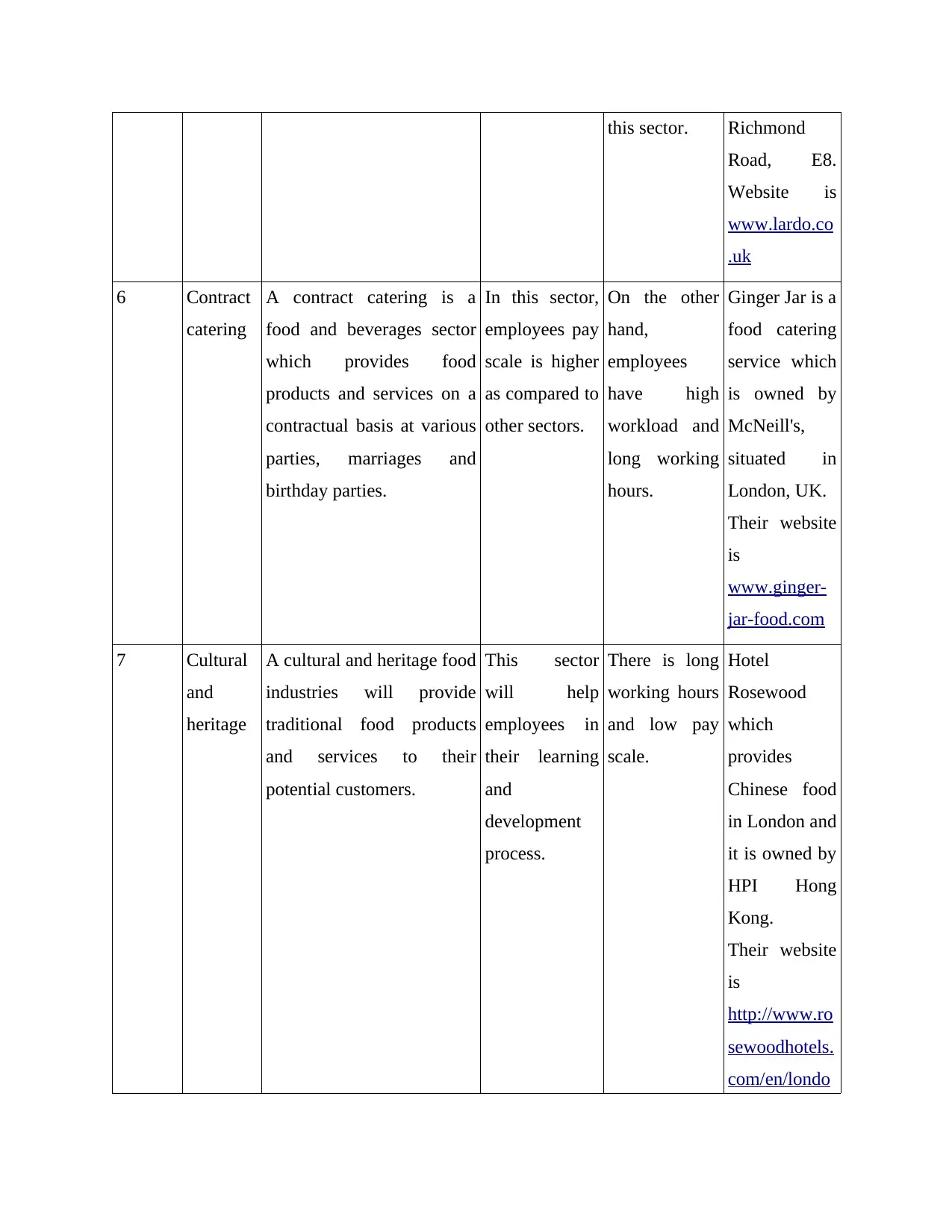
this sector. Richmond
Road, E8.
Website is
www.lardo.co
.uk
6 Contract
catering
A contract catering is a
food and beverages sector
which provides food
products and services on a
contractual basis at various
parties, marriages and
birthday parties.
In this sector,
employees pay
scale is higher
as compared to
other sectors.
On the other
hand,
employees
have high
workload and
long working
hours.
Ginger Jar is a
food catering
service which
is owned by
McNeill's,
situated in
London, UK.
Their website
is
www.ginger-
jar-food.com
7 Cultural
and
heritage
A cultural and heritage food
industries will provide
traditional food products
and services to their
potential customers.
This sector
will help
employees in
their learning
and
development
process.
There is long
working hours
and low pay
scale.
Hotel
Rosewood
which
provides
Chinese food
in London and
it is owned by
HPI Hong
Kong.
Their website
is
http://www.ro
sewoodhotels.
com/en/londo
Road, E8.
Website is
www.lardo.co
.uk
6 Contract
catering
A contract catering is a
food and beverages sector
which provides food
products and services on a
contractual basis at various
parties, marriages and
birthday parties.
In this sector,
employees pay
scale is higher
as compared to
other sectors.
On the other
hand,
employees
have high
workload and
long working
hours.
Ginger Jar is a
food catering
service which
is owned by
McNeill's,
situated in
London, UK.
Their website
is
www.ginger-
jar-food.com
7 Cultural
and
heritage
A cultural and heritage food
industries will provide
traditional food products
and services to their
potential customers.
This sector
will help
employees in
their learning
and
development
process.
There is long
working hours
and low pay
scale.
Hotel
Rosewood
which
provides
Chinese food
in London and
it is owned by
HPI Hong
Kong.
Their website
is
http://www.ro
sewoodhotels.
com/en/londo
Paraphrase This Document
Need a fresh take? Get an instant paraphrase of this document with our AI Paraphraser
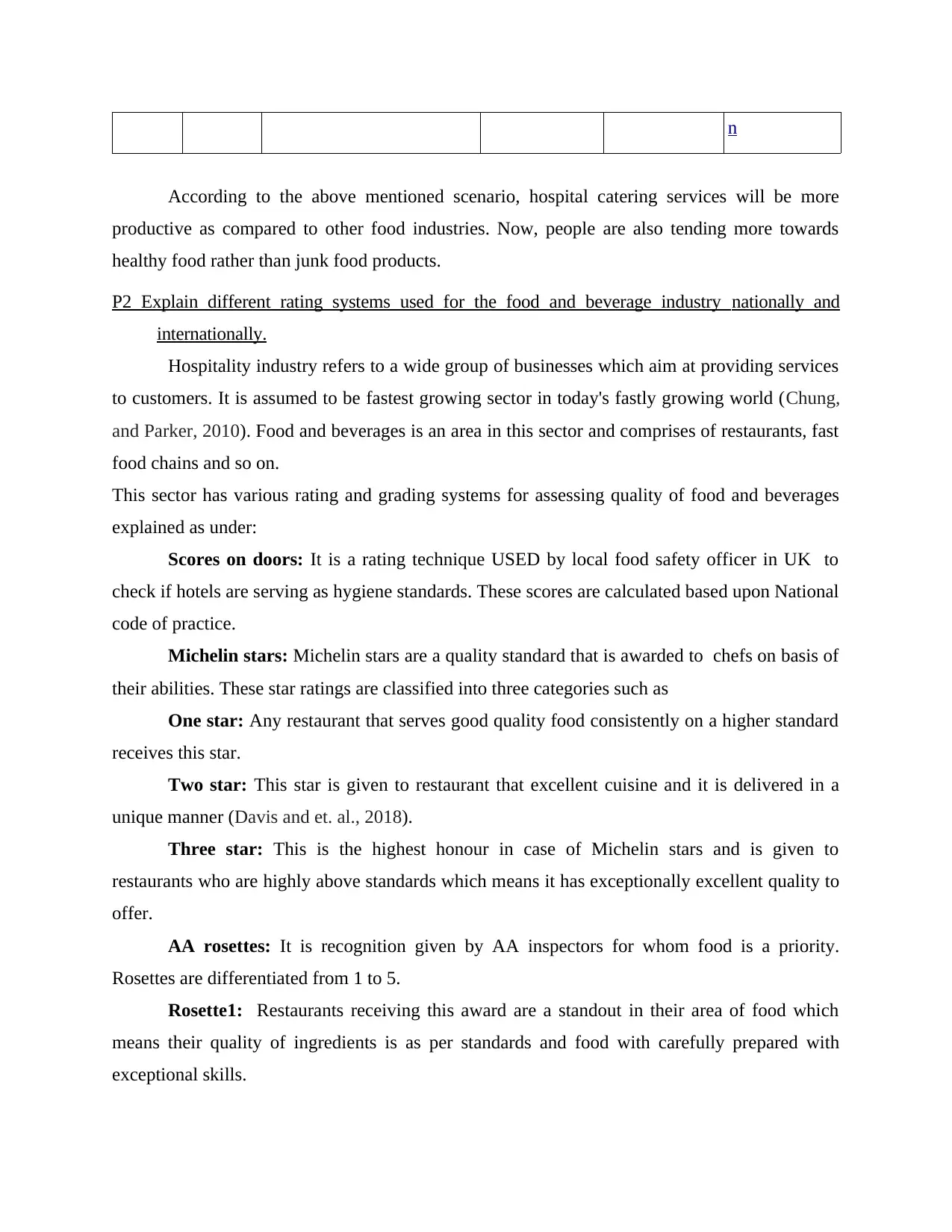
n
According to the above mentioned scenario, hospital catering services will be more
productive as compared to other food industries. Now, people are also tending more towards
healthy food rather than junk food products.
P2 Explain different rating systems used for the food and beverage industry nationally and
internationally.
Hospitality industry refers to a wide group of businesses which aim at providing services
to customers. It is assumed to be fastest growing sector in today's fastly growing world (Chung,
and Parker, 2010). Food and beverages is an area in this sector and comprises of restaurants, fast
food chains and so on.
This sector has various rating and grading systems for assessing quality of food and beverages
explained as under:
Scores on doors: It is a rating technique USED by local food safety officer in UK to
check if hotels are serving as hygiene standards. These scores are calculated based upon National
code of practice.
Michelin stars: Michelin stars are a quality standard that is awarded to chefs on basis of
their abilities. These star ratings are classified into three categories such as
One star: Any restaurant that serves good quality food consistently on a higher standard
receives this star.
Two star: This star is given to restaurant that excellent cuisine and it is delivered in a
unique manner (Davis and et. al., 2018).
Three star: This is the highest honour in case of Michelin stars and is given to
restaurants who are highly above standards which means it has exceptionally excellent quality to
offer.
AA rosettes: It is recognition given by AA inspectors for whom food is a priority.
Rosettes are differentiated from 1 to 5.
Rosette1: Restaurants receiving this award are a standout in their area of food which
means their quality of ingredients is as per standards and food with carefully prepared with
exceptional skills.
According to the above mentioned scenario, hospital catering services will be more
productive as compared to other food industries. Now, people are also tending more towards
healthy food rather than junk food products.
P2 Explain different rating systems used for the food and beverage industry nationally and
internationally.
Hospitality industry refers to a wide group of businesses which aim at providing services
to customers. It is assumed to be fastest growing sector in today's fastly growing world (Chung,
and Parker, 2010). Food and beverages is an area in this sector and comprises of restaurants, fast
food chains and so on.
This sector has various rating and grading systems for assessing quality of food and beverages
explained as under:
Scores on doors: It is a rating technique USED by local food safety officer in UK to
check if hotels are serving as hygiene standards. These scores are calculated based upon National
code of practice.
Michelin stars: Michelin stars are a quality standard that is awarded to chefs on basis of
their abilities. These star ratings are classified into three categories such as
One star: Any restaurant that serves good quality food consistently on a higher standard
receives this star.
Two star: This star is given to restaurant that excellent cuisine and it is delivered in a
unique manner (Davis and et. al., 2018).
Three star: This is the highest honour in case of Michelin stars and is given to
restaurants who are highly above standards which means it has exceptionally excellent quality to
offer.
AA rosettes: It is recognition given by AA inspectors for whom food is a priority.
Rosettes are differentiated from 1 to 5.
Rosette1: Restaurants receiving this award are a standout in their area of food which
means their quality of ingredients is as per standards and food with carefully prepared with
exceptional skills.
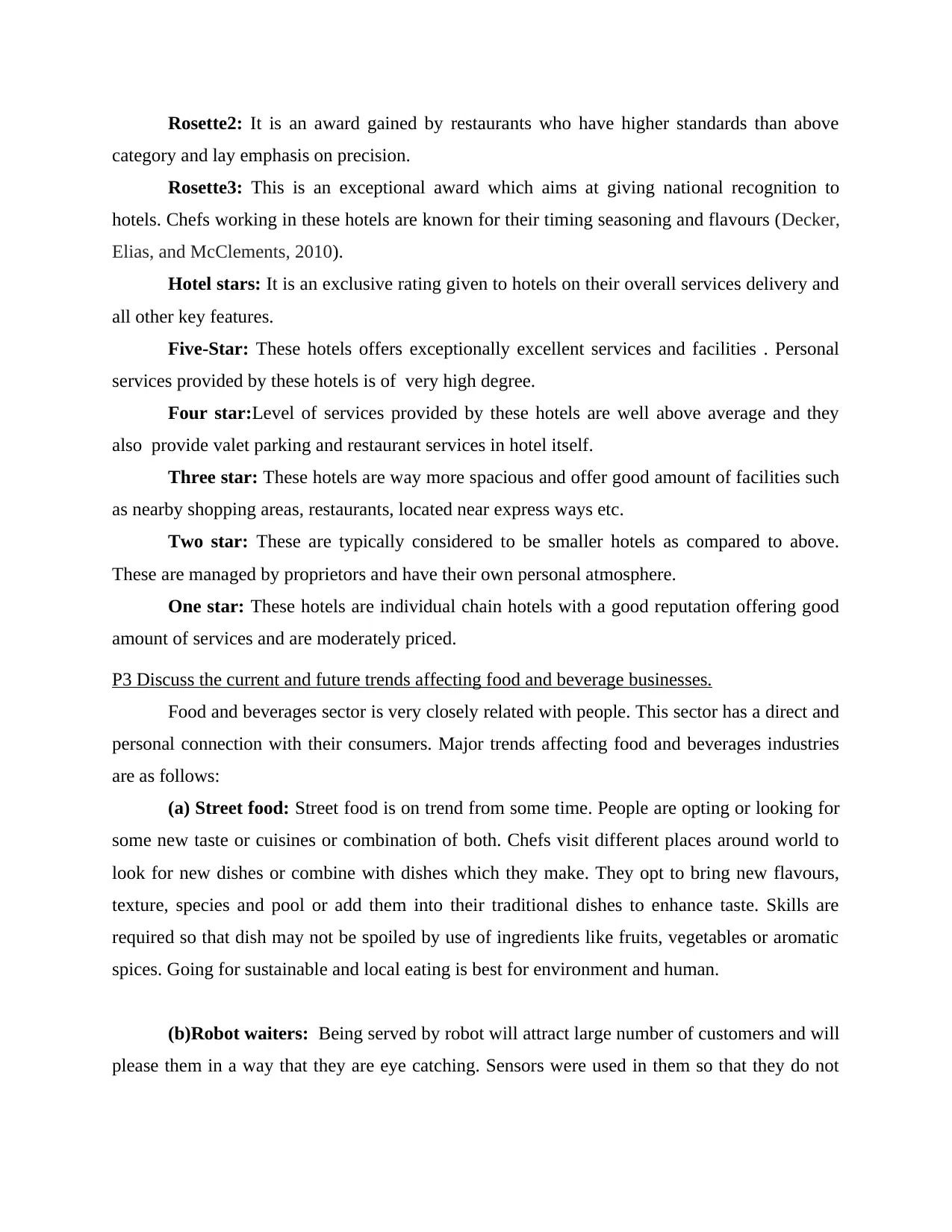
Rosette2: It is an award gained by restaurants who have higher standards than above
category and lay emphasis on precision.
Rosette3: This is an exceptional award which aims at giving national recognition to
hotels. Chefs working in these hotels are known for their timing seasoning and flavours (Decker,
Elias, and McClements, 2010).
Hotel stars: It is an exclusive rating given to hotels on their overall services delivery and
all other key features.
Five-Star: These hotels offers exceptionally excellent services and facilities . Personal
services provided by these hotels is of very high degree.
Four star:Level of services provided by these hotels are well above average and they
also provide valet parking and restaurant services in hotel itself.
Three star: These hotels are way more spacious and offer good amount of facilities such
as nearby shopping areas, restaurants, located near express ways etc.
Two star: These are typically considered to be smaller hotels as compared to above.
These are managed by proprietors and have their own personal atmosphere.
One star: These hotels are individual chain hotels with a good reputation offering good
amount of services and are moderately priced.
P3 Discuss the current and future trends affecting food and beverage businesses.
Food and beverages sector is very closely related with people. This sector has a direct and
personal connection with their consumers. Major trends affecting food and beverages industries
are as follows:
(a) Street food: Street food is on trend from some time. People are opting or looking for
some new taste or cuisines or combination of both. Chefs visit different places around world to
look for new dishes or combine with dishes which they make. They opt to bring new flavours,
texture, species and pool or add them into their traditional dishes to enhance taste. Skills are
required so that dish may not be spoiled by use of ingredients like fruits, vegetables or aromatic
spices. Going for sustainable and local eating is best for environment and human.
(b)Robot waiters: Being served by robot will attract large number of customers and will
please them in a way that they are eye catching. Sensors were used in them so that they do not
category and lay emphasis on precision.
Rosette3: This is an exceptional award which aims at giving national recognition to
hotels. Chefs working in these hotels are known for their timing seasoning and flavours (Decker,
Elias, and McClements, 2010).
Hotel stars: It is an exclusive rating given to hotels on their overall services delivery and
all other key features.
Five-Star: These hotels offers exceptionally excellent services and facilities . Personal
services provided by these hotels is of very high degree.
Four star:Level of services provided by these hotels are well above average and they
also provide valet parking and restaurant services in hotel itself.
Three star: These hotels are way more spacious and offer good amount of facilities such
as nearby shopping areas, restaurants, located near express ways etc.
Two star: These are typically considered to be smaller hotels as compared to above.
These are managed by proprietors and have their own personal atmosphere.
One star: These hotels are individual chain hotels with a good reputation offering good
amount of services and are moderately priced.
P3 Discuss the current and future trends affecting food and beverage businesses.
Food and beverages sector is very closely related with people. This sector has a direct and
personal connection with their consumers. Major trends affecting food and beverages industries
are as follows:
(a) Street food: Street food is on trend from some time. People are opting or looking for
some new taste or cuisines or combination of both. Chefs visit different places around world to
look for new dishes or combine with dishes which they make. They opt to bring new flavours,
texture, species and pool or add them into their traditional dishes to enhance taste. Skills are
required so that dish may not be spoiled by use of ingredients like fruits, vegetables or aromatic
spices. Going for sustainable and local eating is best for environment and human.
(b)Robot waiters: Being served by robot will attract large number of customers and will
please them in a way that they are eye catching. Sensors were used in them so that they do not
⊘ This is a preview!⊘
Do you want full access?
Subscribe today to unlock all pages.

Trusted by 1+ million students worldwide
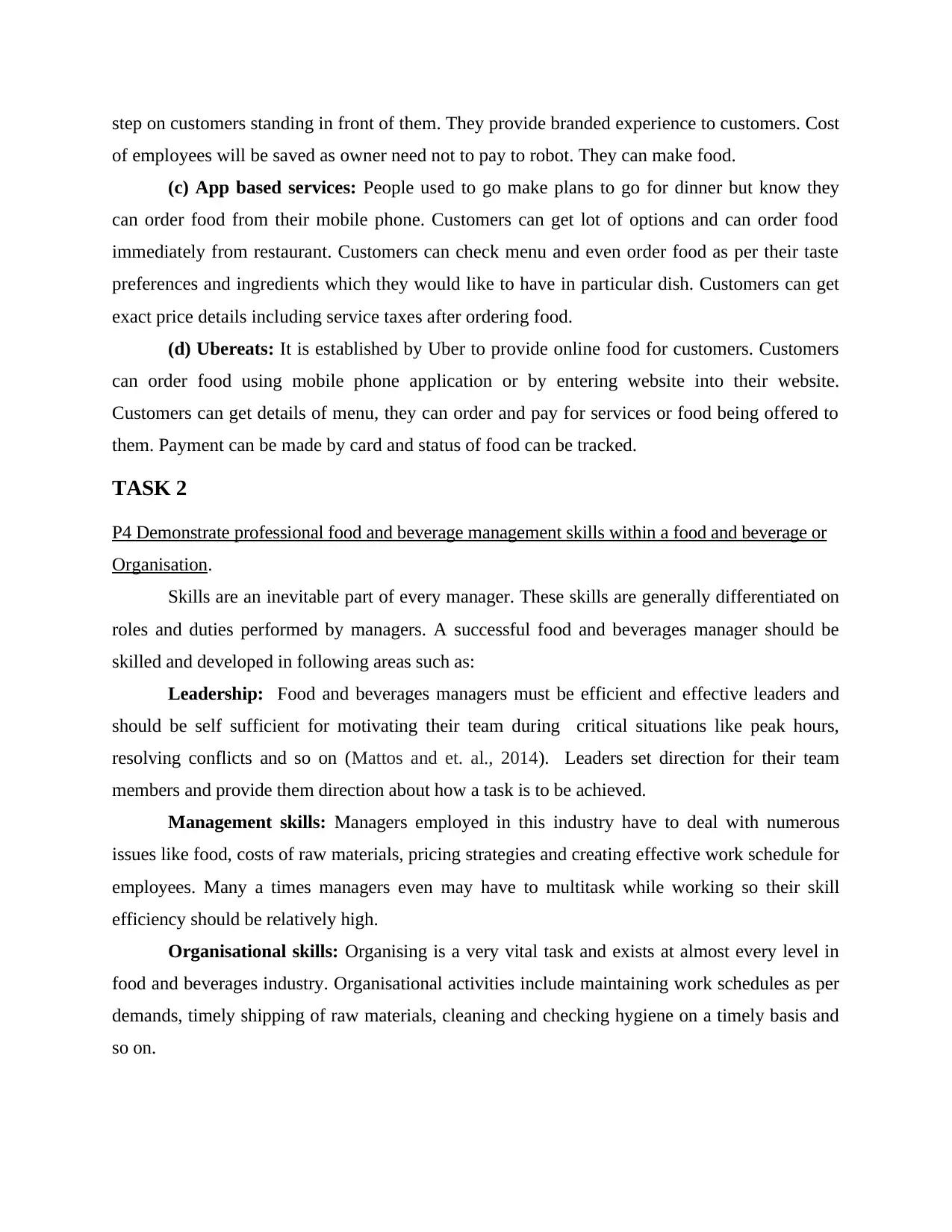
step on customers standing in front of them. They provide branded experience to customers. Cost
of employees will be saved as owner need not to pay to robot. They can make food.
(c) App based services: People used to go make plans to go for dinner but know they
can order food from their mobile phone. Customers can get lot of options and can order food
immediately from restaurant. Customers can check menu and even order food as per their taste
preferences and ingredients which they would like to have in particular dish. Customers can get
exact price details including service taxes after ordering food.
(d) Ubereats: It is established by Uber to provide online food for customers. Customers
can order food using mobile phone application or by entering website into their website.
Customers can get details of menu, they can order and pay for services or food being offered to
them. Payment can be made by card and status of food can be tracked.
TASK 2
P4 Demonstrate professional food and beverage management skills within a food and beverage or
Organisation.
Skills are an inevitable part of every manager. These skills are generally differentiated on
roles and duties performed by managers. A successful food and beverages manager should be
skilled and developed in following areas such as:
Leadership: Food and beverages managers must be efficient and effective leaders and
should be self sufficient for motivating their team during critical situations like peak hours,
resolving conflicts and so on (Mattos and et. al., 2014). Leaders set direction for their team
members and provide them direction about how a task is to be achieved.
Management skills: Managers employed in this industry have to deal with numerous
issues like food, costs of raw materials, pricing strategies and creating effective work schedule for
employees. Many a times managers even may have to multitask while working so their skill
efficiency should be relatively high.
Organisational skills: Organising is a very vital task and exists at almost every level in
food and beverages industry. Organisational activities include maintaining work schedules as per
demands, timely shipping of raw materials, cleaning and checking hygiene on a timely basis and
so on.
of employees will be saved as owner need not to pay to robot. They can make food.
(c) App based services: People used to go make plans to go for dinner but know they
can order food from their mobile phone. Customers can get lot of options and can order food
immediately from restaurant. Customers can check menu and even order food as per their taste
preferences and ingredients which they would like to have in particular dish. Customers can get
exact price details including service taxes after ordering food.
(d) Ubereats: It is established by Uber to provide online food for customers. Customers
can order food using mobile phone application or by entering website into their website.
Customers can get details of menu, they can order and pay for services or food being offered to
them. Payment can be made by card and status of food can be tracked.
TASK 2
P4 Demonstrate professional food and beverage management skills within a food and beverage or
Organisation.
Skills are an inevitable part of every manager. These skills are generally differentiated on
roles and duties performed by managers. A successful food and beverages manager should be
skilled and developed in following areas such as:
Leadership: Food and beverages managers must be efficient and effective leaders and
should be self sufficient for motivating their team during critical situations like peak hours,
resolving conflicts and so on (Mattos and et. al., 2014). Leaders set direction for their team
members and provide them direction about how a task is to be achieved.
Management skills: Managers employed in this industry have to deal with numerous
issues like food, costs of raw materials, pricing strategies and creating effective work schedule for
employees. Many a times managers even may have to multitask while working so their skill
efficiency should be relatively high.
Organisational skills: Organising is a very vital task and exists at almost every level in
food and beverages industry. Organisational activities include maintaining work schedules as per
demands, timely shipping of raw materials, cleaning and checking hygiene on a timely basis and
so on.
Paraphrase This Document
Need a fresh take? Get an instant paraphrase of this document with our AI Paraphraser
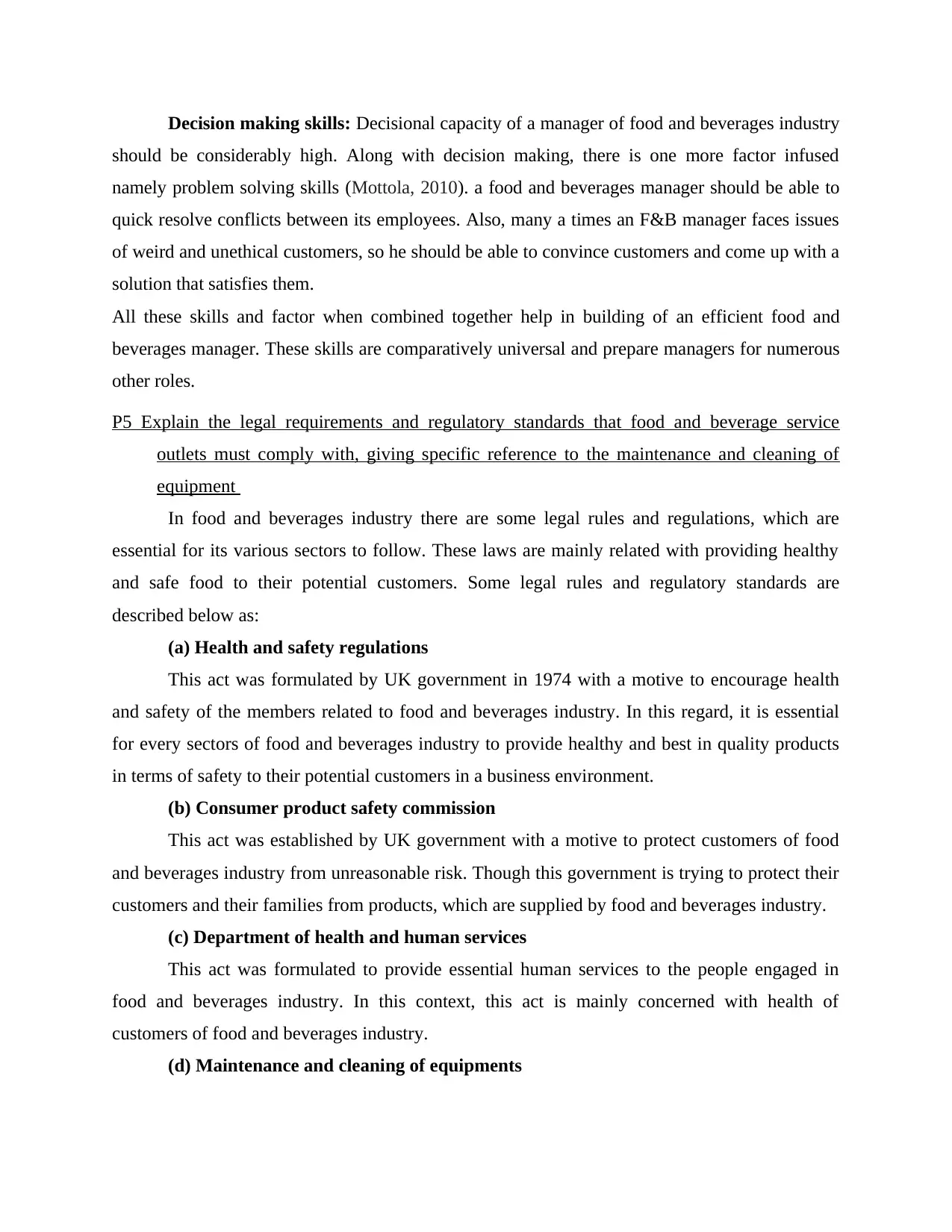
Decision making skills: Decisional capacity of a manager of food and beverages industry
should be considerably high. Along with decision making, there is one more factor infused
namely problem solving skills (Mottola, 2010). a food and beverages manager should be able to
quick resolve conflicts between its employees. Also, many a times an F&B manager faces issues
of weird and unethical customers, so he should be able to convince customers and come up with a
solution that satisfies them.
All these skills and factor when combined together help in building of an efficient food and
beverages manager. These skills are comparatively universal and prepare managers for numerous
other roles.
P5 Explain the legal requirements and regulatory standards that food and beverage service
outlets must comply with, giving specific reference to the maintenance and cleaning of
equipment
In food and beverages industry there are some legal rules and regulations, which are
essential for its various sectors to follow. These laws are mainly related with providing healthy
and safe food to their potential customers. Some legal rules and regulatory standards are
described below as:
(a) Health and safety regulations
This act was formulated by UK government in 1974 with a motive to encourage health
and safety of the members related to food and beverages industry. In this regard, it is essential
for every sectors of food and beverages industry to provide healthy and best in quality products
in terms of safety to their potential customers in a business environment.
(b) Consumer product safety commission
This act was established by UK government with a motive to protect customers of food
and beverages industry from unreasonable risk. Though this government is trying to protect their
customers and their families from products, which are supplied by food and beverages industry.
(c) Department of health and human services
This act was formulated to provide essential human services to the people engaged in
food and beverages industry. In this context, this act is mainly concerned with health of
customers of food and beverages industry.
(d) Maintenance and cleaning of equipments
should be considerably high. Along with decision making, there is one more factor infused
namely problem solving skills (Mottola, 2010). a food and beverages manager should be able to
quick resolve conflicts between its employees. Also, many a times an F&B manager faces issues
of weird and unethical customers, so he should be able to convince customers and come up with a
solution that satisfies them.
All these skills and factor when combined together help in building of an efficient food and
beverages manager. These skills are comparatively universal and prepare managers for numerous
other roles.
P5 Explain the legal requirements and regulatory standards that food and beverage service
outlets must comply with, giving specific reference to the maintenance and cleaning of
equipment
In food and beverages industry there are some legal rules and regulations, which are
essential for its various sectors to follow. These laws are mainly related with providing healthy
and safe food to their potential customers. Some legal rules and regulatory standards are
described below as:
(a) Health and safety regulations
This act was formulated by UK government in 1974 with a motive to encourage health
and safety of the members related to food and beverages industry. In this regard, it is essential
for every sectors of food and beverages industry to provide healthy and best in quality products
in terms of safety to their potential customers in a business environment.
(b) Consumer product safety commission
This act was established by UK government with a motive to protect customers of food
and beverages industry from unreasonable risk. Though this government is trying to protect their
customers and their families from products, which are supplied by food and beverages industry.
(c) Department of health and human services
This act was formulated to provide essential human services to the people engaged in
food and beverages industry. In this context, this act is mainly concerned with health of
customers of food and beverages industry.
(d) Maintenance and cleaning of equipments
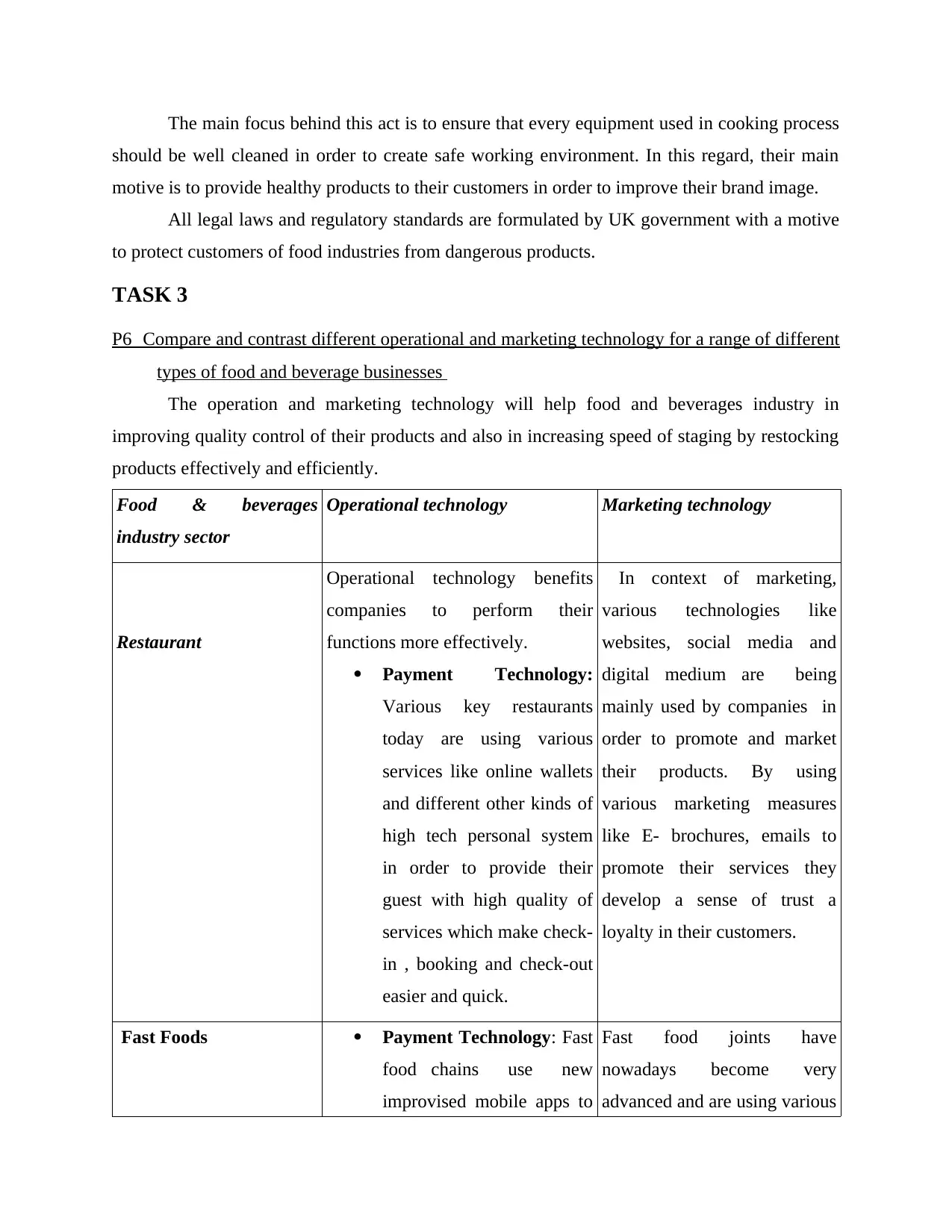
The main focus behind this act is to ensure that every equipment used in cooking process
should be well cleaned in order to create safe working environment. In this regard, their main
motive is to provide healthy products to their customers in order to improve their brand image.
All legal laws and regulatory standards are formulated by UK government with a motive
to protect customers of food industries from dangerous products.
TASK 3
P6 Compare and contrast different operational and marketing technology for a range of different
types of food and beverage businesses
The operation and marketing technology will help food and beverages industry in
improving quality control of their products and also in increasing speed of staging by restocking
products effectively and efficiently.
Food & beverages
industry sector
Operational technology Marketing technology
Restaurant
Operational technology benefits
companies to perform their
functions more effectively.
Payment Technology:
Various key restaurants
today are using various
services like online wallets
and different other kinds of
high tech personal system
in order to provide their
guest with high quality of
services which make check-
in , booking and check-out
easier and quick.
In context of marketing,
various technologies like
websites, social media and
digital medium are being
mainly used by companies in
order to promote and market
their products. By using
various marketing measures
like E- brochures, emails to
promote their services they
develop a sense of trust a
loyalty in their customers.
Fast Foods Payment Technology: Fast
food chains use new
improvised mobile apps to
Fast food joints have
nowadays become very
advanced and are using various
should be well cleaned in order to create safe working environment. In this regard, their main
motive is to provide healthy products to their customers in order to improve their brand image.
All legal laws and regulatory standards are formulated by UK government with a motive
to protect customers of food industries from dangerous products.
TASK 3
P6 Compare and contrast different operational and marketing technology for a range of different
types of food and beverage businesses
The operation and marketing technology will help food and beverages industry in
improving quality control of their products and also in increasing speed of staging by restocking
products effectively and efficiently.
Food & beverages
industry sector
Operational technology Marketing technology
Restaurant
Operational technology benefits
companies to perform their
functions more effectively.
Payment Technology:
Various key restaurants
today are using various
services like online wallets
and different other kinds of
high tech personal system
in order to provide their
guest with high quality of
services which make check-
in , booking and check-out
easier and quick.
In context of marketing,
various technologies like
websites, social media and
digital medium are being
mainly used by companies in
order to promote and market
their products. By using
various marketing measures
like E- brochures, emails to
promote their services they
develop a sense of trust a
loyalty in their customers.
Fast Foods Payment Technology: Fast
food chains use new
improvised mobile apps to
Fast food joints have
nowadays become very
advanced and are using various
⊘ This is a preview!⊘
Do you want full access?
Subscribe today to unlock all pages.

Trusted by 1+ million students worldwide
1 out of 16
Related Documents
Your All-in-One AI-Powered Toolkit for Academic Success.
+13062052269
info@desklib.com
Available 24*7 on WhatsApp / Email
![[object Object]](/_next/static/media/star-bottom.7253800d.svg)
Unlock your academic potential
Copyright © 2020–2025 A2Z Services. All Rights Reserved. Developed and managed by ZUCOL.





